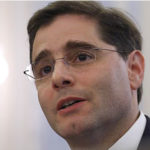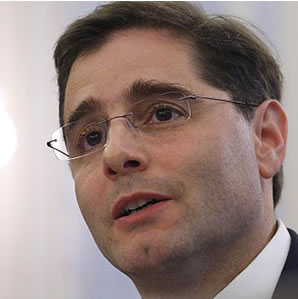
College faculty whose campuses are surrounded by neighborhoods that rely on antiquated dial-up internet connections are hoping the Federal Communication Commission’s National Broadband Plan will bring faster connections that won’t send students running to their campus’s high-speed network every time they need to complete an assignment online.
The plan, unveiled March 16 after a year of intense deliberation among the FCC and various stakeholders, seeks to bring broadband internet to 100 million U.S. homes by 2020. Fourteen million Americans don’t have broadband access, even if they want a high-speed option, according to federal estimates.
Ultra high-speed connections—at least 1 gigabit per second, or 100 times faster than a typical broadband network—also would be made available at “anchor institutions” such as hospitals, libraries, and colleges, according to the FCC’s plan.
The FCC did not detail the cost of the broadband expansion, but commissioners have said auctioning portions of national airwaves would help fund the massive program. That money would add to the $7.2 billion allocated for high-speed internet in the economic stimulus package passed by Congress last year.
“The status quo is not good enough for America,” said FCC Chairman Julius Genachowski, who mentioned the broadband plan’s potential for expanding the use of eBooks in education during his March 16 address. “If we don’t act, we are at risk.”
The FCC launched a web site detailing the National Broadband Plan and offering a “spectrum dashboard,” where visitors can research how local broadband spectrums are being used, and what spectrum is available in nearby counties. The site also features a “consumer broadband test” where Americans can test the quality of their web connection.
High-speed internet has become commonplace on U.S. college campuses of every size, while students and faculty members who live in towns around campus sometimes have spotty or nonexistent broadband connections, making the basics of modern-day distance learning impossible.
Aron Goldman, an adjunct faculty member of the University of Massachusetts Amherst campus, said academics and students in nearby Shutesbury, Mass.—a 10-minute drive from the university—are relegated to dial-up connections that make it difficult to complete the most basic online exercises, such as sending eMail messages with large attachments.
“It’s not a luxury,” said Goldman, who served on a panel last October that discussed sparse high-speed web connections in western Massachusetts with Gov. Deval Patrick. “It’s as essential as electricity … especially for students.”
Goldman said course-management system web sites assembled by faculty members are essentially inaccessible away from UMass Amherst’s high-speed web network. Dial-up connections in Shutesbury and other towns in the western part of the state don’t allow students to watch video clips assigned by their professors, he said.
“It just doesn’t compute with people,” Goldman said. “When you tell someone you don’t have [broadband internet], they think you just choose not to have the service because you’re some weird radical or something. … There’s disbelief that this problem even exists.”
Bringing reliable broadband internet service to communities surrounding colleges and universities could persuade students to lay down roots after graduation. But without high-speed web access that has become expected in many American cities, recent graduates might look elsewhere to live and work, Goldman said.
“If they’ve lived on campus during their education and learn to expect that kind of [broadband connection], why the heck would they stick around?” he said.
FCC commissioners and staff members collected more than 75,000 pages of public comments that came from 36 workshops and nine field hearings about the national broadband initiative. The commission posted 131 blog posts on the topic over the past year, drawing almost 1,500 reader comments.
The FCC also ventured into social networking, collecting 335,000 Twitter followers.
Opponents of the FCC’s broadband plan said March 16 that commissioners should bring broadband access to Americans through a more market-based approach.
The Competitive Enterprise Institute, a Washington, D.C.-based public interest group that advocates against government intervention, said in a statement that the FCC’s high-speed internet plan amounted to a failed effort, because “government-centric efforts to expand telecommunications networks suffer from inefficiencies, waste, and fraud.
“Actual consumer demand should drive the growth of broadband networks, not government slush funds,” the statement continued. “Federal programs to subsidize the expansion of broadband service, whether funded via new taxes on broadband users or spectrum auction proceeds, amount to economically destructive wealth-redistribution schemes that divert resources from productive uses to unproductive ones.”
The Technology Policy Institute, a communications industry think tank funded by companies including Verizon, AT&T, and Comcast, have strongly opposed the FCC’s attempt to reclassify broadband internet as a common carriage service, like phone service. This would place far more stringent regulation on broadband services—a move the institute said would stifle industry investment and innovation.
Vice President Joe Biden announced in December that the federal government would begin funding worthy projects that, backed by billions in stimulus dollars, would build long-awaited fiber-optic networks in rural areas not served by high-bandwidth web connections in larger nearby cities.
The University of Maine is among the campuses involved in the broadband expansion program. Maine will partner with Biddleford Internet Corp.—along with several other companies—to build three fiber optic rings across 1,100 miles of rural area with $25.4 million in stimulus funding.
The massive network will connect 10 University of Maine campuses and pass through about 100 communities with more than 110,000 houses, according to the government’s projections.
University of Maine officials said only college campuses located on or near the Interstate-95 corridor have access to reliable broadband connections. Students and faculty in rural areas only have access to networks that are strained as campuses grow and more people connect to the web and use valuable but limited bandwidth.
The University of New Mexico joined the New Mexico State Library to propose a plan designed to give broadband access to 3,000 homes and 1,000 businesses. The plan was awarded $1.4 million in federal funding.
New Mexico is among the states with the fewest web users. The state ranks 36th nationally in broadband access and 46th in percentage of internet users.
About two-thirds of U.S. households have high-speed internet access now. Many people in the remaining one-third could get broadband service but choose not to, because they think it’s too expensive or because they don’t see a need for it. The FCC plan calls for increasing adoption rates to more than 90 percent of the population, in part by creating a Digital Literacy Corps to teach people how to use the internet.
When rural areas lack broadband access, it’s often because phone and cable companies haven’t found it worthwhile to invest in dragging high-speed lines to remote places that would have few subscribers. One way the FCC hopes to expand broadband use is with wireless technology.
The wireless industry currently licenses about 500 megahertz of the wireless spectrum. In a move akin to adding more lanes to a freeway, the FCC hopes to free up another 500 MHz over the next decade, both for licensed purposes and for uses that don’t require a license, such as Wi-Fi networks. The agency hopes to get roughly 120 MHz of that spectrum from broadcasters of free, over-the-air TV. It would allow broadcasters to unload frequencies they don’t need and share in the proceeds raised by auctioning those airwaves to wireless companies.
That proposal has run into fierce resistance from the National Association of Broadcasters, however. TV broadcasters already gave up more than 100 MHz of spectrum when they shut off analog signals last year and began broadcasting only in digital. Many say they plan to use their remaining frequencies to transmit high-definition signals, to “multicast” multiple channels, and to deliver mobile TV to phones, laptops, and cars.
The FCC plan also lays out a framework for overhauling the federal Universal Service Fund to pay for expanding broadband instead of basic telephone service. The $8 billion-a-year program, financed by a surcharge that businesses and consumers pay on long-distance bills, was established to subsidize telephone service in sparsely populated places.
Tapping this pool of money for broadband could be an uphill push, too, because the long-distance revenue base that supports the Universal Service Fund is shrinking. The FCC plan offers several options to pay for the new broadband programs, including one that would require no additional money from Congress and one that would accelerate the construction of broadband networks if Congress approves a one-time injection of several billion dollars.
Material from the Associated Press was used in this report.
Links:
Competitive Enterprise Institute
- Research: Social media has negative impact on academic performance - April 2, 2020
- Number 1: Social media has negative impact on academic performance - December 31, 2014
- 6 reasons campus networks must change - September 30, 2014

